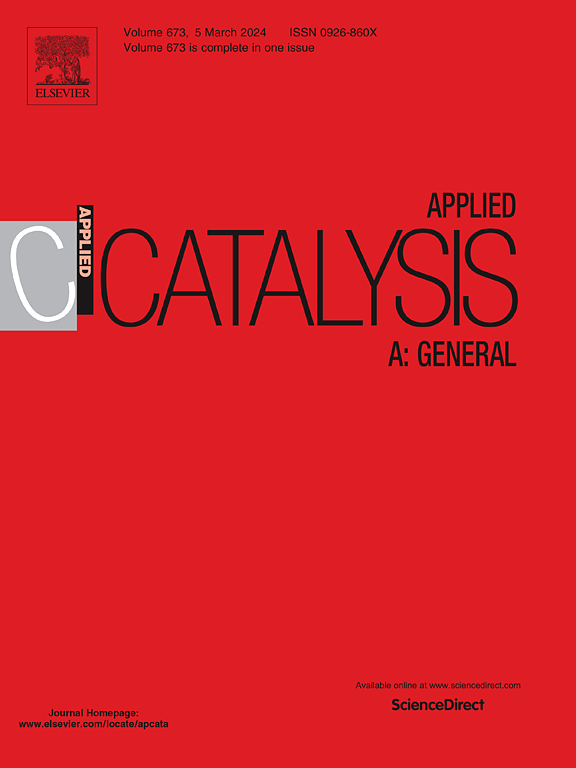Confinement and synergy effect of bimetallic Cu-Ni clusters encapsulated in Beta zeolite for methyl acetate formation from methanol alone
IF 4.8
2区 化学
Q2 CHEMISTRY, PHYSICAL
引用次数: 0
Abstract
The direct synthesis of methyl acetate (MA) from methanol is an appealing and green approach, but an efficient catalyst is urgently needed. Herein, Cu-Ni bimetallic clusters, with a diameter of ∼1.2 nm, have been successfully encapsulated within BEA zeolite by an in-situ two-step encapsulation method (Cu-Ni@Beta), which significantly favors the dispersion of metals compared to the ion-exchanging (Cu/Ni@Beta) and wet impregnation approach (Cu-Ni/Beta). The as-synthesized Cu-Ni@Beta catalyst shows a MA formation rate of 1.46 mmol s−1 g(Cu+Ni)−1, which is much higher than Cu/Ni@Beta of 0.02 mmol s−1 g(Cu+Ni)−1 and Cu-Ni/Beta of 0.12 mmol s−1 g(Cu+Ni)−1. Characterization studies reveal that zeolite constraints could not only provide the spatial confinement for metal clusters but also induce an electronic interaction between confined Cu and Ni species in Cu-Ni@Beta. This interaction can increase and stabilize Cu+ sites as well as Lewis acid sites, which are crucial for improving catalytic performance. In-situ FTIR experiments indicate that the formation of formaldehyde (CH2O*) is the critical step for methanol to MA, and the CH2O* further couples with methoxy (CH3O*) to form acetate species (CH3CHO*), which subsequently couples with CH3O* to produce MA.
β沸石包封Cu-Ni双金属簇对甲醇合成乙酸甲酯的约束和协同效应
甲醇直接合成乙酸甲酯(MA)是一种绿色环保的方法,但迫切需要一种高效的催化剂。本文采用原位两步包封方法(Cu-Ni@Beta)成功地将直径为~ 1.2 nm的Cu- ni双金属簇包封在BEA沸石中,与离子交换(Cu/Ni@Beta)和湿浸渍(Cu- ni /Beta)方法相比,该方法明显有利于金属的分散。合成的Cu-Ni@Beta催化剂的MA生成速率为1.46 mmol s−1 g(Cu+Ni)−1,远高于Cu/Ni@Beta的0.02 mmol s−1 g(Cu+Ni)−1和Cu-Ni/Beta的0.12 mmol s−1 g(Cu+Ni)−1。表征研究表明,沸石约束不仅可以为金属簇提供空间约束,还可以诱导Cu-Ni@Beta中受限Cu和Ni之间的电子相互作用。这种相互作用可以增加和稳定Cu+位点和Lewis酸位点,这对提高催化性能至关重要。原位FTIR实验表明,甲醛(CH2O*)的生成是甲醇生成MA的关键步骤,CH2O*再与甲氧基(ch30 *)偶联生成乙酸(CH3CHO*),乙酸与ch30 *偶联生成MA。
本文章由计算机程序翻译,如有差异,请以英文原文为准。
求助全文
约1分钟内获得全文
求助全文
来源期刊

Applied Catalysis A: General
化学-环境科学
CiteScore
9.00
自引率
5.50%
发文量
415
审稿时长
24 days
期刊介绍:
Applied Catalysis A: General publishes original papers on all aspects of catalysis of basic and practical interest to chemical scientists in both industrial and academic fields, with an emphasis onnew understanding of catalysts and catalytic reactions, new catalytic materials, new techniques, and new processes, especially those that have potential practical implications.
Papers that report results of a thorough study or optimization of systems or processes that are well understood, widely studied, or minor variations of known ones are discouraged. Authors should include statements in a separate section "Justification for Publication" of how the manuscript fits the scope of the journal in the cover letter to the editors. Submissions without such justification will be rejected without review.
 求助内容:
求助内容: 应助结果提醒方式:
应助结果提醒方式:


